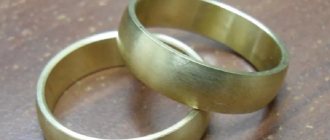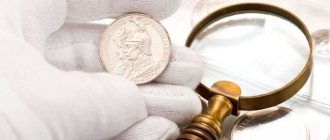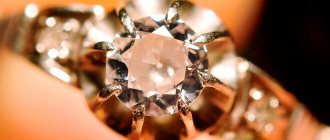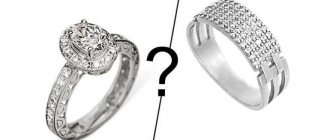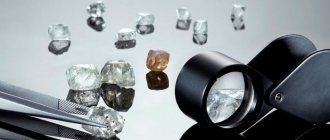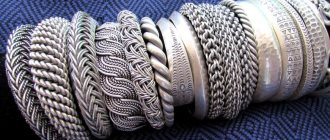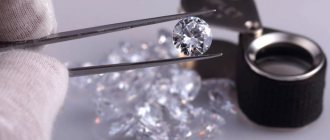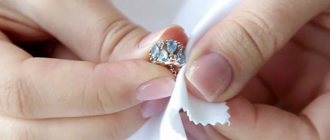Diamonds touch the heart of even the most indifferent people to jewelry - the beauty of this stone is magical. Even if you don’t want to buy a piece of jewelry for your collection, you want to stop for a while in the eternal bustle and admire the brilliance of the edges, the depth of the glow, the delightful play of radiance and diamonds. Their beauty is mesmerizing, as is the cost of stones of excellent quality, cut, and shape. Alas, the jewelry world is not always as flawless as these precious stones; unpleasant surprises and attempts to pass off completely different stones as diamonds do occur. It is not difficult for jewelers and gemologists to recognize a fake, but the buyer often has to rely only on the data in the product certificate.
Avoiding unfair deals is actually not that difficult if you know how to distinguish a diamond from other similar stones. In this review, we will compare the characteristics of the most famous diamond doubles using examples: we are sure that even if you are guided by a photo and faced with a choice in real life, you will learn to notice the most characteristic signs that this is a fake.
What stones are they trying to pass off as diamonds?
We would like to make a reservation right away: in the world of jewelry there are legal analogues of diamonds and this does not mean that the stones are fake. Cubic zirconia artificially created in the USSR and lesser-known moissanites are to one degree or another similar to diamonds, and conscientious sellers always indicate the characteristics of the stones in the certificate. There is plenty of information about cubic zirconia, as well as the stones themselves, but moissanites, from the group of natural carbides, are extremely rare in their natural form and cost a lot, so their synthetic analogues are more common.
| Moissanite improved | Moissanite synthetic | cubic zirconia | Diamond |
In addition to cubic zirconia and moissanites of any origin, under the best conditions, colorless topaz or leucosapphire (a colorless stone of the corundum group) can be roughly similar to diamonds. Attempts to pass off rock crystal as a diamond were also encountered in the non-professional jewelry world, but the properties of this stone are so far from the appearance of a cut diamond that the seller’s cunning was exposed in the first seconds after the display of the mineral or jewelry with it.
| Leucosapphire | Colorless topaz | Rhinestone |
Sapphire and topaz clearly show the natural heavenly shade characteristic of these stones in their natural color - shades of blue, light blue. And if in diamonds the reflections of this spectrum are also well expressed, then in corundum and topaz the color penetrates the entire stone, and does not remain only on the edges. Rock crystal does not have even a third of the light refraction properties that are observed in any diamond, even not of the highest quality.
Methods that should not be used
When answering the question of how to distinguish a diamond, one cannot fail to mention prohibited methods. They can only be used if you don’t mind damaging the fake:
- Hold the pebble over an open fire for a few seconds. If it retains its properties, it is a real diamond. In this case, the moissanite will take on a green tint. However, it will not be possible to restore the original color. He will be hopelessly damaged.
- Immerse the crystal in hydrochloric acid. White streaks will appear on the fake. It will not be possible to remove such traces. A natural diamond will not suffer from such actions.
- If you suspect zirconium, you can run a diamond pencil over the stone. Under the influence of the tool, a clear line will appear on the semi-precious stone. When performing such checks, you should not use too much force, as there is a risk of cracks.
Methods for checking diamonds
If you carefully examine the photographic examples, the first and most significant difference between natural stones and artificial ones is their purity. Natural origin will always be distinguished by the presence of any kind of inclusions inside a diamond (and any other stone); small cracks, so-called “curtains” and other defects, without which no natural stone can do, will be noticeable. It is impossible to create such inclusions in synthetic stones; artificial analogues are always transparent and do not have a single defect.
| Diamond | cubic zirconia |
On some natural stones, these nature marks are visible without magnification, but if you intend to purchase a diamond or a finished product with one, arm yourself with a small loupe with 10x magnification. Such a device is quite inexpensive, a few hundred rubles, offered under the name “binocular magnifying glass,” but it will come in handy many times in life, and not only when buying diamonds.
In addition to a magnifying glass, which will instantly reveal the secret of the origin of the stone by magnifying the inclusions in it, you can identify a diamond using... letters. Yes, yes, you will need any printed text on a light background, even a black line will do. Through cubic zirconia you can even see the letters on a business card, but with a diamond you won’t be able to read it. Moissanite has different optical properties and depends on the type and quality of polishing of the girdle - a ghosting effect may be observed.
| What happens if you look through cubic zirconia and diamond at the line |
Another reliable and simple method will help you distinguish a diamond from a moissanite: you will need a bright flashlight, water, a white sheet and a plastic cover. Place water in the lid, stones in the same place, shine a flashlight from above so that the reflection of the diamonds and moissanites transfers to the paper. The reflections from diamonds will resemble the flame of a gas burner on a home stove, and moissanites, being a quarter brighter than diamonds, will show long beams with a wide spectrum of color.
| Diamonds | Moissanites |
And another, popular and effective way to check whether a diamond is in front of you or not is a transparent glass of water.
If you immerse a diamond in water, it will be impossible to see it in the glass. It is not true.
A diamond in water does not reflect, but the edges of the stone themselves are clearly visible. Diamond analogues - cubic zirconia and moissanite - will produce colored highlights at a certain incidence of light.
| Diamond visible in water | |
We can recommend to the most meticulous and principled buyers a simple and inexpensive device, a tester that focuses on the thermal and light radiation of stones. In popular online stores, such devices are sold for a very reasonable price, less than 1000 rubles, and the efficiency of the device is quite enough to identify a diamond or other stone in a second. There is a limitation: no household tester can recognize diamonds larger than a carat.
What can it be easily confused with?
When purchasing, it is important to check the authenticity of the stone. Thanks to the use of modern technologies, artificial gems have appeared that cannot be distinguished from real ones. Moreover, they are made so well that even testers cannot identify a glass diamond.
The characteristics of the gemstone fully imitate the following fakes:
- Cubic zirconia – it is also called zircon. It is a synthetic stone. The mineral was invented by Soviet physicists. This happened in the seventies of the 20th century. Since then, cubic zirconia has become widespread throughout the world. It can be transparent or colored. Today there are gems of 6 shades.
- Moissanite is considered the most accurate copy. It looks 90% like a jewel and even shines more intensely. It is impossible to recognize moissanite with the naked eye. Even an experienced specialist can make a mistake.
- Rock crystal - resembles a diamond in appearance. If you cut this mineral, it will acquire an intense shine. At the same time, it is combined with silver and sometimes with gold. For cutting diamonds, only platinum and gold settings are used. You can fix the crystal with glue. This type of coating is not usually used when working with diamonds.
In addition, it is important to distinguish a processed diamond from the following gems:
- leucosapphire;
- artificial diamond;
- white beryl;
- combination of synthesized stones;
- white topaz;
- rhinestones.
How to distinguish a diamond from cubic zirconia
It is not difficult to distinguish between a diamond and cubic zirconia placed next to each other if you have already had similar experience or are a jeweler, but there are still characteristic features that are accessible to everyone, without the use of complex equipment.
The same unnatural transparency and complete absence of any kind of defects inside the stone are the first and unconditional exposer of synthetic diamond analogues. Cubic zirconia, also known as cubic zirconium, is also somewhat cloudy when held up to the light. If a large stone is used in jewelry, it is impossible to mistake its origin: cubic zirconia does not look so airy, does not have the play of light even close to the quality of a diamond, and the radiance of the facets is not as luxurious in color.
| cubic zirconia | Diamond | Diamond | cubic zirconia |
However, it would not be entirely correct to devalue the beauty of cubic zirconia, since these stones most often accompany sapphires, emeralds, rubies, and other precious and semi-precious stones. It is very beautiful and at the same time practical, since the cost of the product is reduced, but the appearance is not attractive.
| Cubic zirconias and sapphires | Ruby with cubic zirconia | GT emerald and cubic zirconia | Topaz with cubic zirconia |
Note!
If it is quite easy to recognize cubic zirconia in a large stone, then with small sizes you should be more careful. You can check the diamond in front of you and the cubic zirconia without instruments if you breathe on the stones. A natural diamond, even a small one, will not fog up, but cubic zirconias will develop a characteristic haze.
Weight
To determine the authenticity of products, you can weigh them on carat scales. This method is based on the fact that the size of the jewelry must correspond to the carat weight. One carat corresponds to 0.2 g. Moreover, zircons are 2 times heavier compared to diamonds. Therefore, identifying a fake will not be difficult.
Frame
Jewelers treat the production of diamond jewelry very carefully. With the help of the frame it is possible to disguise small defects and other inclusions. The finished product should look high quality. At the same time, the metal, frame and fastening buttons help to distinguish a real product from a budget one.
A step-by-step check of the decoration looks like this:
- Pure diamonds are usually set in platinum or white gold. This metal perfectly sets off the beauty of the jewelry.
- Colored crystals are most often combined with red or yellow gold. This combination is often used in pendants and earrings.
- A silver frame is considered not expensive enough and looks much simpler. Real crystals are usually combined with more expensive metals.
- Diamonds can be set in different ways. Most often, microscopic metal legs are used for this. A blind mount can also be used. This method is considered quite reliable, but it visually reduces the size of the stone. Corner fastening is used much less often. In this case, the crystal is installed directly into a metal plate. If the gem is installed carelessly, this indicates that it is fake.
- Natural stones are not attached with glue. Artificial gems are usually fixed in this way.
Important! You need to make sure that the setting of the stone is platinum or gold and not silver. To do this, it is recommended to check the stamp that indicates the sample.
Ultraviolet
Answering the question of how you can test a diamond, it is worth recommending a method that is based on the use of ultraviolet light. It is best to use a quartz or ultraviolet lamp. You need to shine such a device on the stone and evaluate the results:
- when exposed to ultraviolet light, diamonds appear bluish;
- if the stone does not react to the action of such rays, it may be glass;
- a grey, yellow or greenish glow indicates moissanite.
Note! Another special feature of diamonds is that they are not visible under X-rays. However, this feature cannot be tested at home.
How to distinguish a diamond from moissanite
The fogging test can also be applied to moissanites, and this is the first thing that an artificial stone will reveal. If natural cubic zirconia does not exist in nature, this is the development of physicists, then with moissanites everything is more complicated. There are natural and synthetic stones. The artificial version of moissanite is more common, and stones weighing half a carat can be purchased for $100-150. A beautiful shine when cut correctly is brighter than a diamond, and the impeccable purity of moissanite, as befits synthetics, adds beauty. It also reveals the artificial origin of the stone. Even the shape of the cut does not affect the brightness and clarity.
| On the left is moissanite, on the right is diamond | On the left is moissanite, on the right is diamond |
It’s not easy to find jewelry with natural moissanite, and it’s not profitable for anyone to pass it off as a diamond – the prices per carat are almost equal. Natural moissanite with a diameter of more than 2 mm has not yet been found, and if you have a larger stone in front of you, it is definitely not natural moissanite, but whether it is a diamond or not needs to be examined separately. Remember? The easiest way is to breathe on the stone. The diamond will not fog up.
Like cubic zirconia, synthetic moissanite is often used as a companion to precious stones, and due to the brighter play of light, moissanite very favorably emphasizes the beauty of natural stones. This synthetic analogue of a diamond with corundum group gemstones looks especially beautiful.
| Moissanite framed with rubies | GT emerald and two moissanites | Sapphire and moissanites |
But any analog is just a replacement of the original, its imitation, and if there were any opportunity in the world to create an artificial stone that exactly replicates the properties of a diamond, its value would not be so high.
Amulets and talismans
Diamond amulets give the owner protection from all negative influences from other people. Well, talismans bring success and good luck.
For good luck in business, a diamond must be combined with the “metal of fire” - gold. Therefore, it is recommended to use this combination in the form of rings and wear them on your left hand. Success in the game will be brought by a talisman in the form of a ring with a diamond, worn on the middle finger of the hand. A man will bring sexual energy if he wears an amulet on his little finger. This option allows you to find new partners without much difficulty.
Women also benefit greatly from wearing diamonds. Earrings and necklaces should include not the single existence of a diamond, but its scattering. This inclusion of stones eliminates masculine character traits in a woman and gives her the energy of charm, love and happiness. If diamond products have defects, then instead of benefit, you can get harm. Therefore, it is necessary to carefully select diamonds for amulets and talismans.
How to distinguish a diamond from rock crystal
This stone has no jewelry value; the mineral is an ordinary variety of quartz and has its same properties. The purity of crystals is the main disadvantage of rock crystal, since the mineral does not have it, and samples with high transparency are rare. However, as in the case of cubic zirconia, you can look through the rock crystal into light and recognize contrasting text or images. The stones can be identified by their cloudy girdle (remember, this is a cut in the middle along the entire circumference), they are characterized by a “gassed” effect - when examining the mineral, you can notice clusters of tiny inclusions.
| You can see the background behind the mineral | Opaque girdle | Lots of small inclusions |
In addition, rather large minerals are used in rock crystal jewelry, and the stones themselves can be recognized by their characteristic, barely noticeable “haze” inside.
Medicinal qualities
Diamond is valued for its energy potential. Its vibrating waves radiate only positive qualities. That is why they can solve many health problems:
- Relieve inflammatory processes and treat diseases of the skin, bronchi, bladder, gastric system and liver.
- Promote the normal functioning of the nervous system, eliminate symptoms of irritation, insomnia, and even in the treatment of schizophrenia it is possible to achieve positive changes.
- Normalize the functioning of the cardiovascular system, improving rhythm and pressure.
- Increase the chance of getting pregnant, and the passage of this stage occurs in a normal state.
There is one very unusual remedy - “diamond water”. This elixir is very easy to prepare. The mineral is placed in water for a day, and the liquid is charged with all the energy and healing properties. After this, you can use the prepared product internally. It helps to quickly recover from operations and complex illnesses.
Well, people who are impulsive and have high blood pressure are not recommended to constantly carry a diamond with them.
Checking a diamond for authenticity in a laboratory or with a specialist
If you buy ready-made jewelry or an accessory with a diamond, it must be accompanied by a gemological certificate or product passport. This procedure is established by law in Russia; the need for examination is determined by the weight of the diamonds. Up to 1 carat, as a rule, a store tag or a certificate in the form of the selling organization is sufficient, but requesting an examination for diamonds up to a carat is the personal choice of the owner.
Stones larger than a carat undergo mandatory examination according to one of the standards. The GIA certificate is valued all over the world - having such a diamond passport in hand, no country in the world will have problems confirming the characteristics of the jewelry, and the characteristics of the stone are described in the document extremely accurately.
If you really want an accurate assessment from an expert, don't go to commercial labs. In such companies, the quality characteristics of the stones are deliberately overstated so as not to lose customers who may not like the rating that is not high enough. Independent laboratories and institutes are the best choice and the most accurate results of testing diamonds for authenticity and quality.
It just so happens in the jewelry world that certificates from Hong Kong, Israel, and Russian commercial laboratories are not trusted. While American grading standards and Russian government centers, on the contrary, have proven the validity of diamond grading.
Magic properties
Diamond, of course, is very valuable, but it is also dangerous for humans if the stone is treated carelessly.
If handled roughly, he can “bear a grudge” and harm his owner. In ancient times, it was believed that the gem brought its owner strength of spirit, courage and determination. Diamond can also cure alcohol and drug addiction. It changes dissolute people for the better. Protects people from a sad state and from the evil eye, wards off witchcraft spells and softens fantasies.
It is worth knowing that the stone is predisposed to high-ranking personalities - kings, high priests or simply famous people. He will serve them faithfully. And towards ordinary people the stone shows its pride and indifference. If a gem is inherited, it can “tame” a person after about 7-10 years. He needs time to understand the essence of the owner and adapt to him. Only in this case is the active work of the mineral possible.
Photos of the most beautiful diamonds in the world
Despite their impeccable beauty, diamonds of special quality have a bloody trail through centuries of history. Alas, the legends have only softened over a long time and have survived to this day in a relatively acceptable form. Of course, the 21st century has finally completed the list of terrible crimes associated with diamonds, and today stones are exhibited, sold at auctions and passed on by inheritance without the frightening crime, as was the case historically. But there are also diamonds that are crystal clear before fate and the law; we give three such examples below.
Please note that even the most famous, highest quality diamonds still have inclusions, albeit tiny ones: these defects are the direct, simple and most honest proof of the authenticity of the gemstones.
Diamond Cullinan
– its two aristocratic parts belong to the sweetest lady from Great Britain, or rather the entire English court. And the complete Cullinan family includes 9 large diamonds and about a hundred small ones. The original diamond measured 11 x 5 x 6 cm and weighed more than 600 grams (3106 carats).
| Cullinan I 530 carat | Cullinan II 317 carats |
Excelsior
– held the title of the largest diamond until the birth of Kulinan. The original weight of the Excelsior diamond was 995 carats, and after cutting, 21 beautiful diamonds were seen, and all of them quickly went to private collections and fashionable jewelry houses.
| The largest of the Excelsiors | Heidi Klum, Excelsior advertising | Diamond before cutting |
Centenary
- closes the top three and at the same time is the most mysterious, albeit infinitely beautiful diamond in the world. 274 carats were cut by professionals from De Beers, and the stone owes its origin to the same mine in South Africa where Cullinan was found. Today Centenary is not exhibited and, moreover, it is unknown where this marvelous diamond, insured for a record amount of $100 million, is located.
The cost of such diamonds is incalculable, and it is unlikely that at least one of them will ever be sold again. The price of 2.5 million dollars for one of these stones is very modest, and a diamond presented by Heidi Klum as a swimsuit decoration was sold for $11 million.
In our store, diamonds are presented, of course, not in such a stellar format, but the authenticity and quality of the stones indicated in the characteristics certainly does not raise doubts or questions.
The catalog of diamond products includes various jewelry and accessories; we are sure that here you can find a gift for yourself or a loved one. All diamond products come with an expert opinion, and when purchasing online there is an additional 5% discount.
Where do diamonds come from in meteorites?
The hypothesis about the meteorite origin of the mineral caused heated discussions, because diamonds were found in some specimens. Today, the overwhelming majority of scientists are inclined to believe that diamonds in meteorites arose as a result of impacts in the asteroid belt. When falling to the ground, a new rock was formed on the surface of the latter - impactites, the conditions for the formation of which correspond to those of diamonds. The particles involved in the impact contain carbon, which under the influence of pressure of 40-50 GPa and temperature of 2-3 thousand degrees Celsius can become diamond.
Impact deposits are a common phenomenon and originated several million years ago. One of the most famous is the Popigai astroproblem, whose diameter reaches 100 km. It is located on the border of modern Krasnoyarsk and Yakutia; the meteorite that fell there had a radius of 3.5 km. At the same time, the extraction of meteorite diamonds is not feasible for industry - they are too small.
